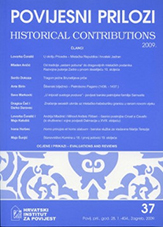Homo principis et homo statuum - banska služba za vladavine Marije Terezije
Homo principis et homo statuum - The office of banus during Maria Theresa’s reign
Author(s): Ivana HorbecSubject(s): History
Published by: Hrvatski institut za povijest
Keywords: the office of banus; history of institutions; Croatian Parliament; Civil Croatia; Maria Theresa; Karlo Batthyány; Franjo Nádasdy
Summary/Abstract: This essay explores the status of the banus as the intermediary between the monarch and the Croatian estates in the government of Civil Croatia. The study focuses on the rule of the Empress Maria Theresa (1740–1780) and the contemporary administrations of two banus, Count Karlo Batthyány (1742–1756) and Count Franjo Nádasdy (1756– 1782). Changes in the office of the banus are placed in the context of the strengthening of the royal sovereignty and the development of the public service of royal governors in Habsburg Monarchy as well as in early modern European monarchies more generally. In Civil Croatia, the intermediary character of the office of the banus brought together accountability towards the monarch as the bearer of royal authority within the country and an equal accountability towards the Croatian estates, as banus was regarded as the basis of the rule of law and the holder of the political authority within Civil Croatia. Within the territory of his jurisdiction, the banus first and foremost occupied the role of the chief military commander. At the same time, he also, in collaboration with the Croatian estates, controlled the civil government that encompassed a large complex of the political, legal, administrative and fiscal rights of the ruler. During the early modern era, the growth of the sovereignty of the monarchs and the centralization of their authority, in relation to the powers of the representative bodies of the estates, came to have a significant impact on the authority and the scope of services of the office of the banus. The key period for both the growth of the royal sovereignty and the centralization of the authority of the monarch was the rule of Maria Theresa, aimed at internal integration of the Monarchy and marked by numerous and far-reaching reforms of the Croatian government. It was in this period that the reform of the tax administration was conducted, the governing structure of the counties as the lowestlevel administrative units was put into place, the terrier regulation was introduced and the public schooling and healthcare were established. The Croatian Royal Council, as the first institution of the executive rule in Civil Croatia, was first established and then abolished. In this period, military skills of the banus came to be seen as of secondary importance, while the Viennese court viewed his office primarily through its role of the royal governor. The office of the banus was integrated into the hierarchy of the state government and bound to obedience to the monarch. At the same time, part of the Croatian estates clung to the idea of their own statehood and of their role as the guardian of the traditional political organization into estates.
Journal: Povijesni prilozi
- Issue Year: 2009
- Issue No: 37
- Page Range: 283-316
- Page Count: 33
- Language: Croatian

